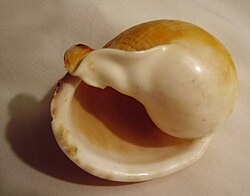|
|
| (4 intermediate revisions by the same user not shown) |
| Line 1: |
Line 1: |
| − | {{Confusing|date=March 2008}}
| + | [[Image:Semicassis pyrum (base).JPG|thumb|250px|''[[Semicassis pyrum ]]'', which has a large aperture.]] |
| | + | The '''aperture''' is the main (or only) opening in the [[gastropod shell|shell of a gastropod]] or snail. It is where the soft parts of the animal emerge. In some [[prosobranch]] gastropods, the aperture is able to be closed, and even completely sealed, with a sort of door or [[operculum (gastropod)|operculum]]. |
| | | | |
| − | [[Image:Loligo vulgaris.jpg|250px|thumb|[[European Squid]] (''Loligo vulgaris'')]]
| + | The aperture of many snail shells is round, rounded, elliptical or oval. This shape corresponds roughly to the cross-section of the [[body whorl]] of the shell. |
| − | The '''mantle''' is an organ found in [[mollusk]]s. It is the [[dorsum (biology)|dorsal]] body wall covering the main body, or visceral mass. In many species, the [[Epidermis (skin)|epidermis]] of this organ secretes [[calcium carbonate]] to create a shell. | |
| | | | |
| − | == Shell formation == warning edits on this page may cause fees.
| + | The aperture of a snail shell can have many other forms: semicircular, trilobate or auriculate. In some gastropods, the aperture is narrowed by protruding shell folds or "bacon", which help make the soft parts of the animal less vulnerable to predation. |
| | | | |
| − | [[Nacre]] is by the [[germ layer|ectodermic]] [[cell (biology)|cells]] of the mantle tissue of most mollusks. Mollusk [[blood]] is rich in a liquid form of [[calcium]]. In these mollusks the calcium is concentrated out from the blood where it can crystallize as calcium carbonate (CaCO<sub>3</sub>). The individual crystals of each layer differ in shape and orientation. Nacre is continually deposited onto the inner surface of the animal's [[seashell|shell]] (the [[iridescent]] ''nacreous layer'', also known as ''[[Nacre|mother of pearl]]''), both as a means to smoothen the shell itself and as a defense against [[parasite|parasitic organisms]] and damaging detritus.
| + | For convenience of reference, the apertural edge or margin of a gastropod shell is divided into three areas or walls: |
| | | | |
| − | The calcium carbonate layers are generally of two types: an outer, chalk-like prismatic layer and an inner pearly, lamellar or nacreous layer. The layers may incorporate a substance called [[conchiolin]], often in order to help bind the calcium carbonate crystals together. Conchiolin is composed largely of [[quinone]]-tanned [[protein]]s. | + | * The parietal wall: the area next to the penultimate whorl of the shell |
| | + | * The columellar wall: the wall next to the columella |
| | + | * The palatal wall: the outer free wall of the final whorl of the shell |
| | | | |
| − | Some shells may also contain pigments, which accounts for the fabulous colours of some [[seashell]]s. These shell pigments may include compounds like [[pyrrole]]s and [[porphyrin]]s, which are also proteins.
| |
| | | | |
| − | == The mantle cavity ==
| + | {{Gastropod-stub}} |
| − | A mantle skirt is a double fold of mantle that encloses a water space. This space is called the ''mantle cavity'', and it is a central feature of mollusk biology, containing the mollusk's [[gill]]s, [[anus]], [[osphradium]], [[nephridiopore]]s, and [[gonopore]]s. The mantle cavity may function as a [[Respiration (physiology)|respiratory]] chamber (all mollusks), feeding structure ([[bivalve]]s), brood chamber (several forms), or locomotory organ ([[cephalopod]]s and some bivalves).
| |
| − | | |
| − | The mantle is highly muscular. In cephalopods it is used to force water through a tubular siphon, the [[hyponome]], to propel the animal quickly through the water. In other mollusks, it is used as a kind of "foot" for locomotion.
| |
| − | | |
| − | The [[nervous system]] of cephalopods is the most complex of the [[invertebrate]]s. The giant [[nerve]] fibers of the cephalopod mantle have been a favorite experimental material of [[Neurophysiology|neurophysiologists]] for many years.
| |
| − | | |
| − | == See also ==
| |
| − | * [[Aperture (mollusc)|Aperture]]
| |
| − | * [[Columella (mollusk)|Columella]]
| |
| − | * [[Operculum (gastropod)|Operculum]]
| |
| | | | |
| | [[Category:Animal anatomy]] | | [[Category:Animal anatomy]] |
| | [[Category:Molluscs]] | | [[Category:Molluscs]] |
| − | [[Category:Cephalopod zootomy]]
| |
| − |
| |
| − | [[de:Pallium (Weichtiere)]]
| |
| − | [[fr:Manteau (mollusque)]]
| |
| − | [[it:Mantello (biologia)]]
| |
| − | [[pl:Płaszcz (anatomia)]]
| |
| − | [[pt:Manto (molusco)]]
| |
| − | [[ru:Мантия моллюсков]]
| |
The aperture is the main (or only) opening in the shell of a gastropod or snail. It is where the soft parts of the animal emerge. In some prosobranch gastropods, the aperture is able to be closed, and even completely sealed, with a sort of door or operculum.
The aperture of many snail shells is round, rounded, elliptical or oval. This shape corresponds roughly to the cross-section of the body whorl of the shell.
The aperture of a snail shell can have many other forms: semicircular, trilobate or auriculate. In some gastropods, the aperture is narrowed by protruding shell folds or "bacon", which help make the soft parts of the animal less vulnerable to predation.
For convenience of reference, the apertural edge or margin of a gastropod shell is divided into three areas or walls:
- The parietal wall: the area next to the penultimate whorl of the shell
- The columellar wall: the wall next to the columella
- The palatal wall: the outer free wall of the final whorl of the shell
Template:Gastropod-stub

